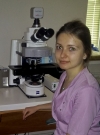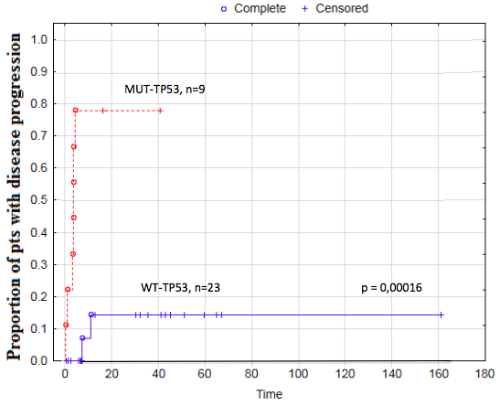
Contributions
Abstract: PB1710
Type: Publication Only
Background
High grade B-cell lymphoma (HGBL) is subdivided on poor prognosis double-hit (DH) and not otherwise specified (NOS) variant, which appears sometimes with primary refractory behavior. Mutations in TP53 gene (MUT-TP53) lead to blockage of apoptosis in cells and appearance of additional oncogenic events contributing to tumor progression. Correlation between presence of MUT-TP53 and anti-tumor response in patients with HGBL is unclear.
Aims
To evaluate an effect of MUT-TP53 on survival parameters of patients with high grade B-cell lymphoma.
Methods
Since 2005 to 2017 years in FGBU National Research Center for Hematology Ministry of Health Russian Federation diagnosis of high grade B-cell lymphoma were established in 47 patients: 13 – double hit, 34 – not otherwise specified. We had available biologic samples from 32 pts with HGBL: 11 – double-hit and 21 – NOS HGBL. 19 pts underwent courses of intensive treatment according to BL-M-04 [Efficacy and toxicity of a new short-term high intensive protocol BL-M-04 for adult patients with Burkitt lymphoma. Baryakh E. et al. Haematologica. 2011; 96 (S2): 391-392], 11 - R-(DA)-EPOCH, 2-R-CHOP-21 treatment. А median follow-up period was 10,8 (0,6-160,9) months. MYC-rearrangement (MYC-R) without BCL2 and/or BCL6 rearrangement was detected in 7 pts with HGBL. Sanger sequencing of DNA extracted from paraffin embedded tumor tissue were performed to reveal mutations in exons 5-8 of TP53 gene. To evaluate an effect on overall survival (OS) and on time to disease progression (of TTP) such factors as MUT-TP53, MYC-R and DH was conducted univariate analysis (test of Kaplan-Meier method, log-rank test) and multivariate variance and Cox regression analysis (STATISTICA 10).
Results
A significant mutations of TP53 were detected in 9 pts (c.535C>T 45,6% p.H179Y, c.524G>C 15,6% p.R175P, c.770T>A 32,4% p.L257Q, c.743G>A 75,6% p.R247Q, c.487T>A 25,2% p.Y163N, c.824G>A 75% p.C275Y, c.713G>A 87,7% p.C238Y, c.517G>A 22,4% p.V173M, c.517G>A 22,4% p.V173M). Pts and their relatives hadn’t a history of primary multiple tumors. Seven from nine pts with MUT-TP53 had MYC-R (3-double hit, 4-single hit lymphoma). Groups of pts with WT-TP53 and MUT-TP53 were comparable for main clinical characteristics. According to results of univariate analysis, patients with MUT-TP53 had lower duration of overall survival a higher probability of disease progression. Thus, median of overall survival in pts with c MUT-TP53 was 7,0 (3,5 - 40,9) vs 30,5 (0,6 - 160,9) months in patients with WT-TP53, (p = 0,03). Median time to disease progression in pts with c MUT-TP53 was 3,5 (0,3 - 16,1) vs 30,5 (0,6 - 160,9) months in patients with WT-TP53, (p = 0,00016). In multivariate analysis, MUT-TP53 was an independent factor of early disease progression in HGBL independently of double-hit status.

Conclusion
Mutations in TP53 gene - a significant predictive factor of early disease progression in high grade B-cell lymphoma.
Session topic: 20. Aggressive Non-Hodgkin lymphoma - Clinical
Keyword(s): MYC, Progression, P53, Non-Hodgkin's lymphoma
Abstract: PB1710
Type: Publication Only
Background
High grade B-cell lymphoma (HGBL) is subdivided on poor prognosis double-hit (DH) and not otherwise specified (NOS) variant, which appears sometimes with primary refractory behavior. Mutations in TP53 gene (MUT-TP53) lead to blockage of apoptosis in cells and appearance of additional oncogenic events contributing to tumor progression. Correlation between presence of MUT-TP53 and anti-tumor response in patients with HGBL is unclear.
Aims
To evaluate an effect of MUT-TP53 on survival parameters of patients with high grade B-cell lymphoma.
Methods
Since 2005 to 2017 years in FGBU National Research Center for Hematology Ministry of Health Russian Federation diagnosis of high grade B-cell lymphoma were established in 47 patients: 13 – double hit, 34 – not otherwise specified. We had available biologic samples from 32 pts with HGBL: 11 – double-hit and 21 – NOS HGBL. 19 pts underwent courses of intensive treatment according to BL-M-04 [Efficacy and toxicity of a new short-term high intensive protocol BL-M-04 for adult patients with Burkitt lymphoma. Baryakh E. et al. Haematologica. 2011; 96 (S2): 391-392], 11 - R-(DA)-EPOCH, 2-R-CHOP-21 treatment. А median follow-up period was 10,8 (0,6-160,9) months. MYC-rearrangement (MYC-R) without BCL2 and/or BCL6 rearrangement was detected in 7 pts with HGBL. Sanger sequencing of DNA extracted from paraffin embedded tumor tissue were performed to reveal mutations in exons 5-8 of TP53 gene. To evaluate an effect on overall survival (OS) and on time to disease progression (of TTP) such factors as MUT-TP53, MYC-R and DH was conducted univariate analysis (test of Kaplan-Meier method, log-rank test) and multivariate variance and Cox regression analysis (STATISTICA 10).
Results
A significant mutations of TP53 were detected in 9 pts (c.535C>T 45,6% p.H179Y, c.524G>C 15,6% p.R175P, c.770T>A 32,4% p.L257Q, c.743G>A 75,6% p.R247Q, c.487T>A 25,2% p.Y163N, c.824G>A 75% p.C275Y, c.713G>A 87,7% p.C238Y, c.517G>A 22,4% p.V173M, c.517G>A 22,4% p.V173M). Pts and their relatives hadn’t a history of primary multiple tumors. Seven from nine pts with MUT-TP53 had MYC-R (3-double hit, 4-single hit lymphoma). Groups of pts with WT-TP53 and MUT-TP53 were comparable for main clinical characteristics. According to results of univariate analysis, patients with MUT-TP53 had lower duration of overall survival a higher probability of disease progression. Thus, median of overall survival in pts with c MUT-TP53 was 7,0 (3,5 - 40,9) vs 30,5 (0,6 - 160,9) months in patients with WT-TP53, (p = 0,03). Median time to disease progression in pts with c MUT-TP53 was 3,5 (0,3 - 16,1) vs 30,5 (0,6 - 160,9) months in patients with WT-TP53, (p = 0,00016). In multivariate analysis, MUT-TP53 was an independent factor of early disease progression in HGBL independently of double-hit status.

Conclusion
Mutations in TP53 gene - a significant predictive factor of early disease progression in high grade B-cell lymphoma.
Session topic: 20. Aggressive Non-Hodgkin lymphoma - Clinical
Keyword(s): MYC, Progression, P53, Non-Hodgkin's lymphoma


